It has now been nearly a month since Russia invaded Ukraine on Feb. 24. Though the shockwaves of this invasion will continue to be felt for years to come, the world has slowly started to process the crisis and to examine the rapid developments in Ukraine more analytically. One clear pattern in particular has emerged from close observation of Russia’s military tactics, Ukraine’s defensive strategies and the international system’s response: The main battlegrounds in this conflict are Ukraine’s cities.
As of March 16, Russian forces were attempting to surround Kyiv, Ukraine’s capital city, from multiple angles, while simultaneously targeting its second-largest city, Kharkiv, and others in the south, including Kherson and Mariupol, which has become a tragic symbol of the devastation caused by Russia’s assault. One of the primary concerns for humanitarian initiatives has also been “evacuating civilians from besieged cities,” according to Samir Puri of the International Institute for Strategic Studies.
This is not surprising. In fact, it fits into a broader trend in warfare. As military researchers Margarita Konaev and John Spencer pointed out in 2018, “more and more of the world’s most violent conflicts are being fought in densely populated urban areas, at a tremendously high cost to the civilians living there.” Whether in Syria, Yemen or Afghanistan, cities have borne the brunt of conflict.

